When it comes to building an ecommerce website, Bigcommerce and Opencart are often top contenders, but which one is better?
Bigcommerce vs Opencart: What is the Difference?
Bigcommerce is a fully hosted ecommerce platform that allows users to build a complete ecommerce website on the Bigcommerce platform and also sell through multiple online channels. Opencart is a self hosted ecommerce platform and requires independent hosting in order to be able to run an Opencart website.
Disclosure: Our site is reader supported, meaning we may earn a commission from purchases made through our links, to learn more, please see our Affiliate Disclosure.
Pricing

Standard
Unlimited Products
Unlimited Bandwidth
$50k Annual Turnover Limit
No Transaction Fee
Unlimited Data Storage
Free SSL Certificate
24/7 Support

Software
Unlimited Products
Bandwidth Depends on Host
No Turnover Limit
No Transaction Fees
Data Storage Depends on Host
SSL Certificate Depends on Host
Support Forum
Comparing the pricing of an open source and hosted ecommerce platform is quite challenging as they operate in different ways.
Bigcommerce is a fully hosted ecommerce platform, which means that the hosting and ecommerce software is bundled together for a monthly fee. One thing to note about the Bigcommerce pricing is that they have annual turnover limits, which means that when your sales hit these thresholds, you are automatically moved on to a larger package.
While this does mean a higher monthly cost, you do get access to more features on the platform, that can be used to help grow your ecommerce website even further.
With Opencart, the software is completely free to use but you are going to have to pay for web hosting, which for a new or small ecommerce website can be had for less than $10/m but as your website grows, you may want to upgrade to more specialised ecommerce quality web hosting than cost upwards of $20.
Free Trial
Bigcommerce, like most hosted ecommerce platforms offer a free trial and you get 15 days to really test the out platform.
Due to Opencart being open source software, you don’t get a free trial but what you can do is buy some cheap hosting for a month, install the Opencart software and try it out for yourself.
Features
Bigcommerce
As one of the biggest names in the industry, it is expected that Bigcommerce comes loaded with a good selection of features and they don’t disappoint as all of the following are included with the standard package:
Ecommerce Tools
- Single Page Checkout
- Product Ratings and Reviews
- Side by Side Product Comparisons
- Promotions and Special Offers
- Discount Codes and Coupons
- Google Trusted Stores
- Abandoned Cart Recovery
Marketing & SEO
- Social Selling
- Email Marketing
- Price comparison site integration
- Loyalty Program
- Google Shopping
- Social Sharing
- Custom Meta Data
- SEO Friendly URLs
- Blog
Reporting
- Number of Orders
- Total Revenue
- Number of Visitors
- Conversion Rate
- Average Order Value
Payment Gateways
- PayPal
- Stripe
- Worldpay
- Sagepay
- Klarna
- Applepay
As mentioned in the pricing section, as you move up through the packages, you do get access to more features as standard with the Bigcommerce platform.
A relatively new feature that Bigcommerce is pushing is their integration with the WordPress CMS, which they refer to as Content + Commerce. This enables businesses with an existing WordPress website to add a fully functioning ecommerce store to their website and offers the security of all the orders being managed through the Bigcommerce dashboard.
Bigcommerce App Store
Even though Bigcommerce is very feature rich, it doesn’t stop there as they have their own app stores, which currently has a selection of over 700 apps across a range of different areas, from marketing to stock management.
Now while the selection of apps is very good, you may need to pay to use them as only a small selection is free. Most of the paid apps within the marketplace are charged on a monthly basis and this is on top of your Bigcommerce subscription.

Opencart
Even though Opencart is a completely free piece of ecommerce software, it does come with a really good set of features as standard, including:
Ecommerce Tools
- Gift Vouchers
- Coupons
- Sell Physical or Digital Products
- Custom Filters for Product Categories
- Reward Points
- Recurring Payments
Marketing & SEO
- Multi Currency
- Multi Lingual
- Product Reviews & Ratings
- Email Marketing
- Custom SEO inc Meta Titles and Descriptions
Reporting
- Transaction
- Sales
- Returns
- Orders
Payment Gateways
- PayPal
- Klarna
- Sagepay
- Worldpay
- Square
As you can see, there is a very large selection of features, some of which are only available more premium packages with other platforms.
Opencart Extension Market
But Opencart isn’t limited to just its core features, they have their own marketplace, which includes over 400 different extensions and these cover a wide variety of features and functionality.
But unfortunately not all of these are free to use as most are created by third-party developers, who understandably charge for their time and experience not only creating but also updating these extensions.
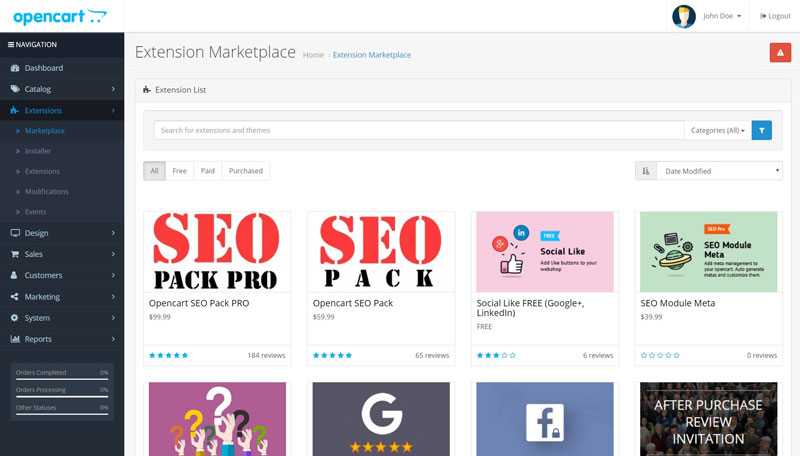
Theme Selection & Customisation
Bigcommerce
Bigcommerce has one of the largest theme selections of all of the fully hosted ecommerce platforms with over 150, free, mobile responsive themes. But unfortunately, only 12 of these are free to use and the remining selection ranges from $150 – $300.
In 2020, Bigcommerce updated their theme customizer and added a page builder, that can be used not only on the homepage but also to build pages for your website, such as an About page. This new page builder includes a selection of widgets, that can be used to add different types of content and layout options to the page.
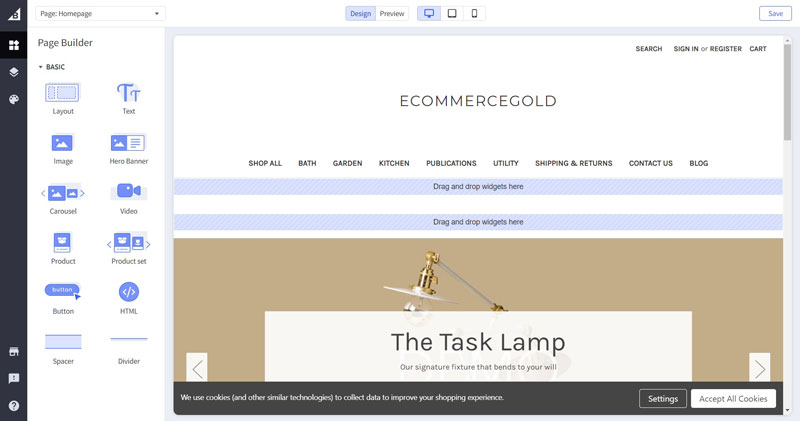
The only real downside to the Bigcommerce theme customisation is that there is only limited control over the theme built in widgets in terms of layout and being able to add/remove them (which also isn’t the most straight forward thing to do). Hopefully, future updates will see this improve.
Opencart
Within the Opencart ecosystem, there is a very small selection of themes. There is the standard, default theme and an additional 18 in the Opencart marketplace but all of these are paid for and cost up to $49. Outside of Opencart, there is a far greater theme selection, with over 850 available on themeforest and many more can be had directly from developers.
While the theme selection is pretty good, theme customisation isn’t! This is because the basic Opencart theme editor requires you to change the .twig code in order to be able to customise the theme, which is something very few people have experience of.
Fortunately, some theme creators have remedied this somewhat by creating their own theme customizer but the amount of options you get does vary from theme to theme. Something like Journal, does come with a good selection of customisation options.
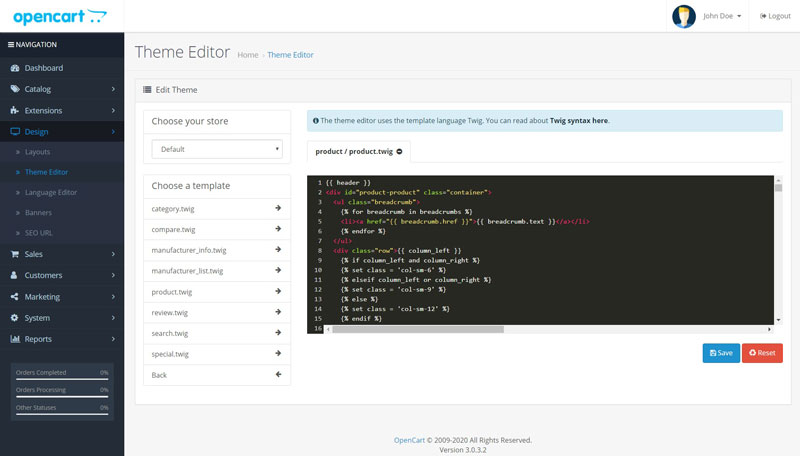
Support
Running an ecommerce website can be challenging at times and you require some help, so what support do you get from these platforms?
Bigcommerce – as Bigcommerce is a fully hosted platform, it is unsurprising that it includes support but what is good about Bigcommerce is that all users get full 24/7 support and this is accessable through a selection of mediums, including over the phone, via live chat or by creating an email support ticket.
Bigcommerce also has a community support forum, which is a great place to as non-urgent questions.
Opencart – with Opencart being an open source piece of software, you don’t get any direct support from the Opencart team but there is a community support forum that can be a useful source of information.
You may also get support from the developers behind some extensions or themes.
Hosting & Performance
Doing a straight up comparison between a hosted and self hosted ecommerce platform isn’t easy, this is because there are many different things that can impact the performance of a self hosted platform, such as hosting, optimisation and the theme/extensions that are being used.
When it comes to hosted platforms, it is much simpler because all sites are hosted in the same environment and with Bigcommerce, you get the following:
- Unlimited Bandwidth
- Unlimited Data Storage
- PCI Compliant Servers
- Global CDN’s
- 99%+ Uptime
But I still wanted to do a comparison between the two platforms to give you an idea of the performance, so I took three of the Bigcommerce customer example sites and ran them through Pingdom’s speed test tool (Washington D.C & San Francisco servers) and Google’s page speed insights, once a day for three days.
I also took my Opencart demo site and ran it through Pingdom (D.C server) and Google’s Page Speed Insights.

Washington D.C: 2.84 Seconds
San Francisco: 3.43 Seconds
Google Mobile: 12/100
Google Desktop: 48/100

Washington D.C: 1.18 Seconds
San Francisco: N/A
Google Mobile: 86/100
Google Desktop: 97/100
A very strong performance from Opencart but this is only a demo site, so doesn’t have a large amount of content or any extensions or third party themes installed but the results do back up Opencart’s claims that their platform is light and performs well.
The Bigcommerce performance was not that great, especially considering all of their stores are hosted on the Google Cloud Platform, which is one of the better hosting platforms out there. From these tests, there is definitely some room for improvement with the Bigcommerce hosting set up.
Ease of Use
Facts and figures are one thing but what are these platforms like to use and how do they compare to each other? Well that is what I am going to be looking at in this section.
Getting Started
Bigcommerce
Getting started with Bigcommerce as all you need is an email address and create a password, you will then be asked a few questions about where your business is currently at, so that they can tailor the dashboard more towards your business.
After you have finished the set up process, you will be taken through to the admin dashboard and on your first sign in, you are greeted by a short but concise set up guide. The dashboard will also include links to helpful articles on the Bigcommerce blog and also some apps or features that might be useful.

Outside of the set up guide, the Bigcommerce dashboard is very easy to navigate due the simple side bar navigation menu, that makes it very simple to move from section to section with the dashboard.
Opencart
Getting started with Opencart is a bit more complicated as it is not a case of just signing up and you are good to go. Instead, you need to first get your hosting set up and then install the Opencart software. Some web hosts may do this for you but others will require you to do it yourself.
Fortunately, there are some very useful guides online to help you do this.
Once you have got Opencart installed, you can then sign in to your dashboard and unlike most platforms, there is no set up or start up guide, you are basically left to figure it out for yourself. This isn’t great because every platform has its own learning curve and not having a guide to help you get started just makes this curve steeper.
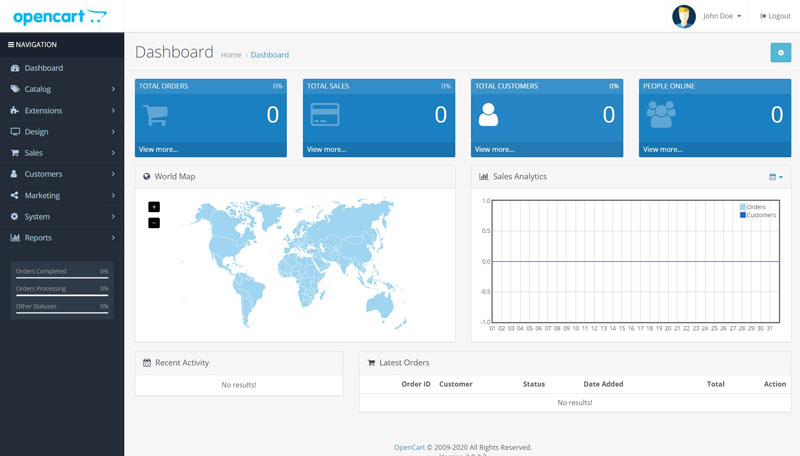
Navigating around the admin area is pretty easy to do as they have also gone for a sidebar navigation menu but something aren’t quite where you would expect them to be.
For example, setting up your payment gateways and delivery methods requires you to go into extensions and then install and set up the required extension. This is a little unusual as on most ecommerce platforms, these are usually set up within the main settings options (system on Opencart).
It is little quirks like this that would make having some sort of set up guide a valuable resource but how it currently works just makes getting started with Opencart more difficult than it needs to be.
Adding and Managing Stock
Being able to manage your stock efficiently and effectively is a hugely important part of running an online store and for me there are three main areas to this and they are:
- Adding products
- Organising your Products
- Managing your inventory
Bigcommerce
Bigcommerce has one of the most comprehensive single page layouts for adding an new product, so much so that they have included a secondary sidebar that allows you to quickly navigate between the sections on the page.
But the page is very simple and easy to use and really doesn’t take long to get used to using. The sidebar also makes it very easy to come in and edit the product as you can quickly navigate to the section that you want to change.
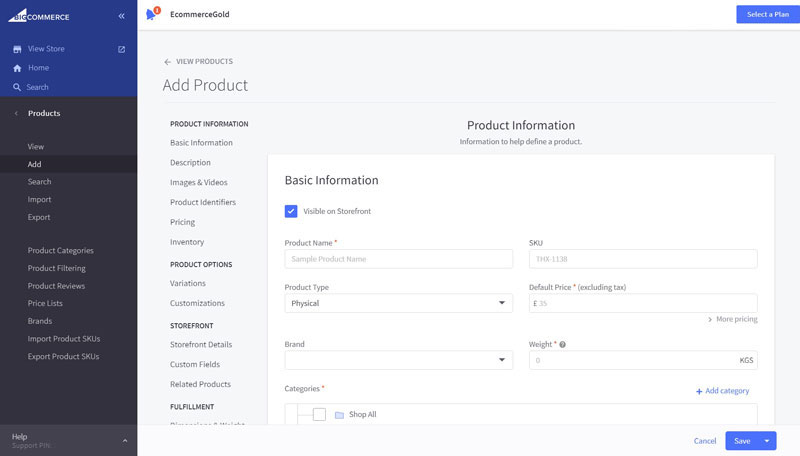
To help you organise your inventory, Bigcommerce have kept things very simple by using the traditional category system and this allows users to create both parent and child categories.
One of the things that really makes Bigcommerce stand apart from their competition is their bulk editors as they allow you to easily manage your inventory, without having to go in and edit the products one by one. It is also a very easy tool to use as it operates in a similar way to a spreadsheet, which many people will have experience of using.
Opencart
Adding a new product in Opencart is not quite as easy, mainly due to the way that the add new cart page is laid out. This is because they have opted for a tabbed structure but there are also many different options and settings within these tabs and it doesn’t feel particularly intuitive to use.
This means that it does take a few goes at adding a new product to really get the hang of the system and to make sure that you have set the product up properly before sending it live.
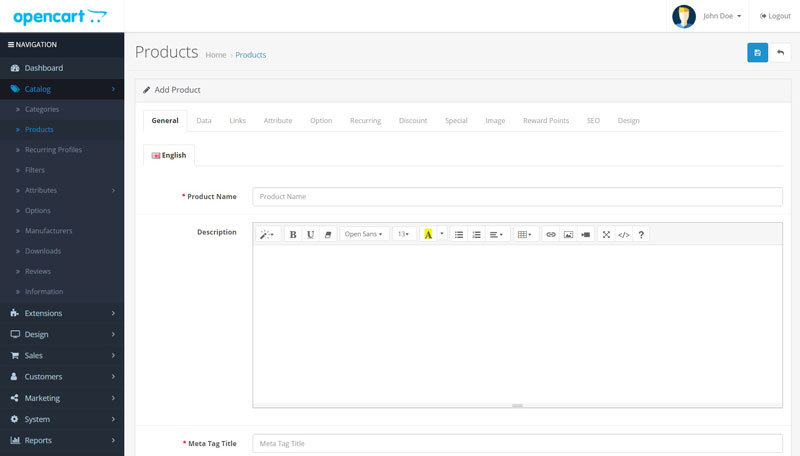
Fortunately, organising your products within Opencart is much simpler as the category system is pretty easy and straightforward to use and allows the creation of both parent and child categories to make a nice category structure.
Managing your inventory on Opencart isn’t great though as there is no bulk editor, this means that if you want to update your stock levels or prices, then it has to be done on a product by product basis, which could be very time consuming if you have a large inventory, which is constantly changing.
Managing Orders
Bigcommerce – Order management in BigCommerce is very good as they allow users to manage their orders either individually or in bulk. For bulk management, it offers printing of invoices/packing slips, updating order statuses and also export order information in CSV format.
You can tell that the Bigcommerce system has been designed for businesses of all sizes and it doesn’t matter whether you only have a couple of orders a day or hundreds, it will easily cope.
Opencart – Order management in Opencart is ok, this is because you can print off order invoices/packing slips directly from the order overview page but this is the most you can do in bulk. To update order statuses, requires updating every order individually and there is no export option. So while it is useable, it isn’t great.
Conclusion
Bigcommerce vs Opencart – Which one is the Best Ecommerce Platform
There is only one winner of this contest and that is Bigcommerce.
This is because Bigcommerce offer a more complete and overall better ecommerce platform than Opencart in terms of features, ease of use, theme customization and support.
It is not perfect though, the performance isn’t great and the theme editor could do with a little more tweaking but overall it is a very capable platform and is suitable for businesses of all sizes.
Opencart could be a very good self-hosted platform but there is a combination of things that let it down, the main one being that it isn’t particularly beginner/user friendly and it doesn’t feel like the platform has kept pace with its competition over the years. This is evident by the lack of theme customisation and bulk editors.
If you want to try either platform out for yourself, you can do by clicking the buttons below.
Try Bigcommerce for Free
15 Day Trial, No Credit Card Required!
Try Opencart for Yourself
Web Hosting Required!
Other Comparisons
Hi, I'm Paul, the Owner and Founder of EcommerceGold.
I ran my own Ecommerce Business for over 7 years and now help others start their own online retail empires!

